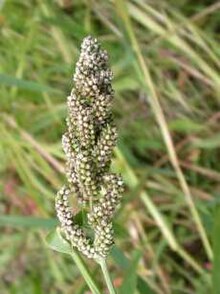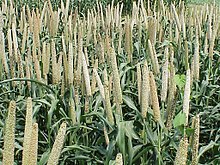Foxtail millet (Setaria italica)
 This is a millet, very easy to grow, very tolerant of drought and very fast growing (can be grown in 2.5 to 3 months). It tolerates slightly cooler conditions than other millets. Native to east Asia, widely cultivated as fodder and hay; domesticated since old times. Consumed as food only in poor regions of China and India.
This is a millet, very easy to grow, very tolerant of drought and very fast growing (can be grown in 2.5 to 3 months). It tolerates slightly cooler conditions than other millets. Native to east Asia, widely cultivated as fodder and hay; domesticated since old times. Consumed as food only in poor regions of China and India.
Seed is tiny, and with orange hull, difficult to remove! Conflictive reports, apparently some varieties are easy to remove papery husk but it´s not the case with the variety I cultivated.
Quite productive. I harvested 400g/m2 in Austria.
Very beautiful when ripe. Bright-brown seed heads, quite heavy when ripe. Susceptive to molds.
Less than 1 meter high. Can be grown quite densely. High biomass. Can be grown in containers.
 This is a millet, very easy to grow and very fast (grown in 2.5 to 3.5 months). Grown in the far East as fooder and also as food, now less popular as rice took over its place.
This is a millet, very easy to grow and very fast (grown in 2.5 to 3.5 months). Grown in the far East as fooder and also as food, now less popular as rice took over its place.
Seeds are also tiny. Light brown hull is very difficult to remove!
Not as productive as foxtail millet, but it will produce lateral seed heads.
Dries very easily after harvesting.
Taller than 1 meter. Can be grown also densely. Can be grown in containers.
Proso millet (Panicum milliaceum)
 This millet thrives with warmer conditions than the two former millets, and a slightly longer growing season (about 3-4 months). This is the most widely grown millet in the US, usually just as birdseed but also as common millet. Best protein profile than wheat but poor in lysine. Highly alkaline. Irritant leaves make not the best fodder.
This millet thrives with warmer conditions than the two former millets, and a slightly longer growing season (about 3-4 months). This is the most widely grown millet in the US, usually just as birdseed but also as common millet. Best protein profile than wheat but poor in lysine. Highly alkaline. Irritant leaves make not the best fodder.
Best flavour but hull is slightly difficult to remove.
Seeds are large, inverted heads with many gold yellow seeds. Quite beautiful.
Moderately productive.
About 1 meter tall. Requires more space in the soil.
Pearl millet (Pennisetum glaucum)
 This millet requires warmer conditions and a bit longer growing season (about 4 months). This is the most widely grown millet in the world, more than 50%. Native to Mali, then spread eastwards to India. A staple in Nigeria and Namibia. Stands harsh soil conditions, including salinity and drought.
This millet requires warmer conditions and a bit longer growing season (about 4 months). This is the most widely grown millet in the world, more than 50%. Native to Mali, then spread eastwards to India. A staple in Nigeria and Namibia. Stands harsh soil conditions, including salinity and drought.
Easiest hull to remove! :)
Seeds are large, with a whitish grey color.
Not as productive. Enjoys more watering. Goes dormant in drought.
Finger millet or Ragi (Eleusine coracana)

Also relatively easy to grow, slower growing (about 4 months).
Adaptable to high altitudes. Native to east Africa and spread to India, where is quite popular and consumed as food. Grows also in the Himalayans.
No information in hull
No information in how productive it is.
Can be smaller than 1 meter. Smal sized plants, quite peculiar the shape of its seed heads.
Kodo millet (Paspalum scrobiculatum)
 Primarily grown in India. Quite drought tolerant but not widely grown. Or only as famine food.
Primarily grown in India. Quite drought tolerant but not widely grown. Or only as famine food.
Seeds are very small!
And hulls are very difficult to remove!!
Smaller than 1 meter high.
OTHER MILLETS
Teff (Eragrostis tef)
Extremely tiny seeds, easy to remove husk but due to small sized grains the process is somewhat labour intensive. Harvested within 3-4 months. Very small sized plants, like grass. Plants are very dry tolerant, but require warmth. Native to Ethiopia. Sold sometimes as an expensive new healthy flour.
Sorghum (sorghum bicolor)
A common crop, often used as hay, fodder crop or to produce syrup. Rarely consumed as food. Similar to corn in requirements but more tolerant of dry and poor conditions. Needs warmth and a long growing season.
Fonio millet or Acha (Digitaria exilis and Digitaria iburua)
Native to west Africa and as a famine food. Very small seeds and very difficult to remove husk. Available in two species, white fonio and black fonio (the last is less common). Digitalis compacta, known as Raishan is cultivated in Indochina.
MORE OBSCURE MILLETS
Polish millet or crabgrass (Digitaria sanguinalis)
A common European weed, rarely cultivated as grain, but harvested by hand.
Job´s tears (Coix lacryma-jobi)
Cultivated usually only as ornamental.
Browntop millet or signalgrass (Brachiaria spp. or Urochloa spp)
A common forage grass, usually in the tropics or subtropics. Brachiaria deflexa is known as Guinea millet.
 This is a millet, very easy to grow, very tolerant of drought and very fast growing (can be grown in 2.5 to 3 months). It tolerates slightly cooler conditions than other millets. Native to east Asia, widely cultivated as fodder and hay; domesticated since old times. Consumed as food only in poor regions of China and India.
This is a millet, very easy to grow, very tolerant of drought and very fast growing (can be grown in 2.5 to 3 months). It tolerates slightly cooler conditions than other millets. Native to east Asia, widely cultivated as fodder and hay; domesticated since old times. Consumed as food only in poor regions of China and India.Seed is tiny, and with orange hull, difficult to remove! Conflictive reports, apparently some varieties are easy to remove papery husk but it´s not the case with the variety I cultivated.
Quite productive. I harvested 400g/m2 in Austria.
Very beautiful when ripe. Bright-brown seed heads, quite heavy when ripe. Susceptive to molds.
Less than 1 meter high. Can be grown quite densely. High biomass. Can be grown in containers.
Japanese millet or Banyard millet (Echinochloa esculenta)
 This is a millet, very easy to grow and very fast (grown in 2.5 to 3.5 months). Grown in the far East as fooder and also as food, now less popular as rice took over its place.
This is a millet, very easy to grow and very fast (grown in 2.5 to 3.5 months). Grown in the far East as fooder and also as food, now less popular as rice took over its place.Seeds are also tiny. Light brown hull is very difficult to remove!
Not as productive as foxtail millet, but it will produce lateral seed heads.
Dries very easily after harvesting.
Taller than 1 meter. Can be grown also densely. Can be grown in containers.
Proso millet (Panicum milliaceum)
 This millet thrives with warmer conditions than the two former millets, and a slightly longer growing season (about 3-4 months). This is the most widely grown millet in the US, usually just as birdseed but also as common millet. Best protein profile than wheat but poor in lysine. Highly alkaline. Irritant leaves make not the best fodder.
This millet thrives with warmer conditions than the two former millets, and a slightly longer growing season (about 3-4 months). This is the most widely grown millet in the US, usually just as birdseed but also as common millet. Best protein profile than wheat but poor in lysine. Highly alkaline. Irritant leaves make not the best fodder.Best flavour but hull is slightly difficult to remove.
Seeds are large, inverted heads with many gold yellow seeds. Quite beautiful.
Moderately productive.
About 1 meter tall. Requires more space in the soil.
Pearl millet (Pennisetum glaucum)
 This millet requires warmer conditions and a bit longer growing season (about 4 months). This is the most widely grown millet in the world, more than 50%. Native to Mali, then spread eastwards to India. A staple in Nigeria and Namibia. Stands harsh soil conditions, including salinity and drought.
This millet requires warmer conditions and a bit longer growing season (about 4 months). This is the most widely grown millet in the world, more than 50%. Native to Mali, then spread eastwards to India. A staple in Nigeria and Namibia. Stands harsh soil conditions, including salinity and drought.Easiest hull to remove! :)
Seeds are large, with a whitish grey color.
Not as productive. Enjoys more watering. Goes dormant in drought.
Taller than 1 meter high. Requires more space in the soil. Sensitive to wind.
Finger millet or Ragi (Eleusine coracana)

Also relatively easy to grow, slower growing (about 4 months).
Adaptable to high altitudes. Native to east Africa and spread to India, where is quite popular and consumed as food. Grows also in the Himalayans.
No information in hull
No information in how productive it is.
Can be smaller than 1 meter. Smal sized plants, quite peculiar the shape of its seed heads.
Kodo millet (Paspalum scrobiculatum)
 Primarily grown in India. Quite drought tolerant but not widely grown. Or only as famine food.
Primarily grown in India. Quite drought tolerant but not widely grown. Or only as famine food.Seeds are very small!
And hulls are very difficult to remove!!
Smaller than 1 meter high.
OTHER MILLETS
Teff (Eragrostis tef)
Extremely tiny seeds, easy to remove husk but due to small sized grains the process is somewhat labour intensive. Harvested within 3-4 months. Very small sized plants, like grass. Plants are very dry tolerant, but require warmth. Native to Ethiopia. Sold sometimes as an expensive new healthy flour.
Sorghum (sorghum bicolor)
A common crop, often used as hay, fodder crop or to produce syrup. Rarely consumed as food. Similar to corn in requirements but more tolerant of dry and poor conditions. Needs warmth and a long growing season.
Native to west Africa and as a famine food. Very small seeds and very difficult to remove husk. Available in two species, white fonio and black fonio (the last is less common). Digitalis compacta, known as Raishan is cultivated in Indochina.
MORE OBSCURE MILLETS
Polish millet or crabgrass (Digitaria sanguinalis)
A common European weed, rarely cultivated as grain, but harvested by hand.
Job´s tears (Coix lacryma-jobi)
Cultivated usually only as ornamental.
Browntop millet or signalgrass (Brachiaria spp. or Urochloa spp)
A common forage grass, usually in the tropics or subtropics. Brachiaria deflexa is known as Guinea millet.
